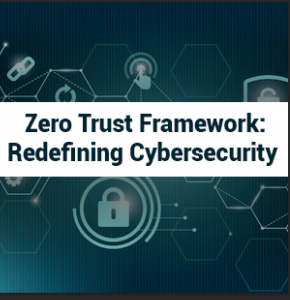
In the ever-evolving cybersecurity landscape, traditional security models are no longer sufficient to protect against the sophisticated threats organizations face today.
Enter the Zero Trust Framework with our Cyber Security Consultant on Long Island, a revolutionary approach that redefines how we think about and implement cybersecurity.
This comprehensive model assumes that threats could be outside and inside the network, and therefore, no entity should be trusted by default.
This blog will explore the Zero Trust Framework's principles, key components, benefits, and how organizations can implement it to bolster their cybersecurity posture.
What is the Zero Trust Framework?
The Zero Trust Framework is a security model based on "never trust, always verify."
Unlike traditional security approaches that rely on perimeter defenses, Zero Trust operates under the assumption that threats can exist both outside and inside the network.
As such, every access request is treated as potentially hostile and must be verified before access is granted.
This model requires continuous verification of user identities, device health, and application behaviors, ensuring that only authorized and secure entities can access critical resources.
Principles of Zero Trust
The Zero Trust Framework is built on several core principles that guide its implementation:
1. Verify Explicitly
Every access request must be explicitly verified, regardless of where it originates. This involves using multiple authentication factors, validating device health, and ensuring the request's legitimacy. Verification is continuous and dynamic, adapting to changing conditions and potential threats.
2. Least Privilege Access
Users and devices should only be granted the minimum access necessary to perform their functions. This principle minimizes the potential damage caused by compromised accounts or devices. Implementing least privilege access involves defining precise access controls and regularly reviewing and adjusting permissions.
3. Assume Breach
Organizations must operate assuming that a breach has either occurred or will occur in the future. This mindset drives the need for robust detection and response capabilities and continuous monitoring of all network activities. By assuming breaches, organizations can better prepare for and mitigate the impact of security incidents.
Critical Components of the Zero Trust Framework
To effectively implement a Zero Trust strategy, organizations must focus on several key components:
1. Identity and Access Management (IAM)
IAM is a critical component of Zero Trust, ensuring that only authenticated and authorized users can access resources. This involves implementing multi-factor authentication (MFA), single sign-on (SSO), and role-based access controls (RBAC). IAM solutions should continuously monitor user behavior for anomalies indicating a compromised account.
2. Device Security
Every device that connects to the network must be verified and monitored to ensure it meets security standards. This involves maintaining an inventory of all devices, implementing endpoint protection solutions, and ensuring devices are regularly updated and patched. Device security also includes monitoring for signs of compromise and taking immediate action when issues are detected.
3. Network Segmentation
Network segmentation involves dividing the network into smaller, isolated segments, each with its access controls. This limits the lateral movement of attackers within the network and contains the impact of a breach. Micro-segmentation, which involves creating even smaller and more specific segments, further enhances security by ensuring that access is tightly controlled at a granular level.
4. Data Protection
Protecting sensitive data is a cornerstone of the Zero Trust Framework. This involves encrypting data at rest and in transit, implementing data loss prevention (DLP) solutions, and continuously monitoring data access and usage. Data protection measures should be applied consistently across all environments, including on-premises, cloud, and hybrid environments.
Protect sensitive data from cyber threats by outsourcing our cybersecurity services in Long Island
5. Continuous Monitoring and Analytics
Zero Trust requires continuous monitoring of all network activities to detect and respond to potential threats in real-time. This involves using advanced analytics, machine learning, and threat intelligence to identify suspicious behaviors and anomalies. Continuous monitoring also includes regular auditing and compliance checks to ensure security policies are followed.
Benefits of the Zero Trust Framework
Adopting a zero-trust approach offers numerous benefits that enhance an organization’s overall security posture:
1. Reduced Attack Surface
By limiting access to only what is necessary and continuously verifying every request, Zero Trust reduces the potential points of entry for attackers. Network segmentation minimizes the attack surface by containing breaches to more minor, isolated segments.
2. Enhanced Visibility and Control
Zero Trust provides comprehensive visibility into all network activities, allowing organizations to monitor and control access to resources more effectively. This visibility is critical for detecting and responding to threats quickly and efficiently.
3. Improved Threat Detection and Response
Continuous monitoring and advanced analytics enable organizations to detect and respond to threats in real-time. By assuming breach, Zero Trust ensures that organizations are always prepared to handle security incidents, reducing the impact of breaches.
4. Compliance and Regulatory Alignment
Zero Trust helps organizations meet compliance and regulatory requirements by implementing stringent access controls, continuous monitoring, and robust data protection measures. This ensures that sensitive data is adequately protected and security policies are consistently enforced.
Implementing the Zero Trust Framework
To successfully implement the Zero Trust Framework, organizations should follow these best practices:
1. Assess Current Security Posture
Assess your organization’s security posture to identify gaps and areas for improvement. This involves thoroughly reviewing existing security controls, access policies, and network architecture.
2. Define Clear Access Policies
Develop precise and granular access policies based on the principle of least privilege. Define roles and permissions for users and devices and implement multi-factor authentication to ensure access requests are adequately verified.
3. Segment the Network
Implement network segmentation and micro-segmentation to isolate critical assets and limit the lateral movement of attackers. Define access controls for each segment and regularly review and update segmentation policies.
4. Deploy Advanced Security Solutions
Invest in advanced security solutions like IAM, endpoint protection, DLP, and continuous monitoring tools. These solutions should be integrated into a cohesive security strategy that supports the Zero Trust principles.
5. Continuous Monitoring and Adaptation
Implement continuous monitoring and analytics to detect and respond to threats in real-time. Regularly review and update security policies, access controls, and monitoring tools to adapt to evolving threats and changing business needs.
6. Educate and Train Employees
Educate and train employees on Zero Trust principles and cybersecurity's importance. Ensure that all users understand the need for strict access controls and know the best practices for maintaining security.
Challenges in Adopting Zero Trust
While the Zero Trust framework offers significant security benefits, implementing it can be challenging. Common challenges include:
Complexity: Zero Trust requires a comprehensive overhaul of existing security architectures, which can be complex and resource-intensive.
Integration: Integrating Zero Trust components with existing systems and applications may require significant effort and expertise.
Cost: The initial investment in Zero Trust technologies and infrastructure can be substantial, although the long-term benefits often justify the expense.
Change Management: Shifting to a Zero Trust model requires changes in organizational culture and processes, which can be met with resistance.
Conclusion
The Zero Trust Framework redefines cybersecurity by shifting the focus from perimeter defenses to continuous verification and strict access controls. By implementing Zero Trust, organizations can significantly enhance their security posture, reduce the attack surface, and improve threat detection and response capabilities. As cyber threats continue to evolve, adopting a zero-trust approach is essential for safeguarding critical assets and ensuring the resilience of your organization’s IT infrastructure.
Transform your cybersecurity strategy with the Zero Trust Framework. Contact us today to learn how our comprehensive Zero Trust solutions can help protect your organization from evolving threats.
Tags: Cyber Security Consultant Long Island, Cyber Security Services Long Island





